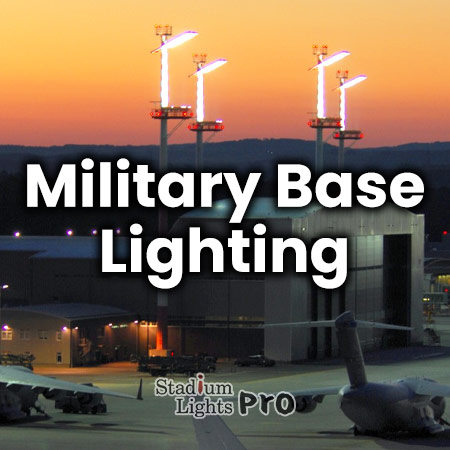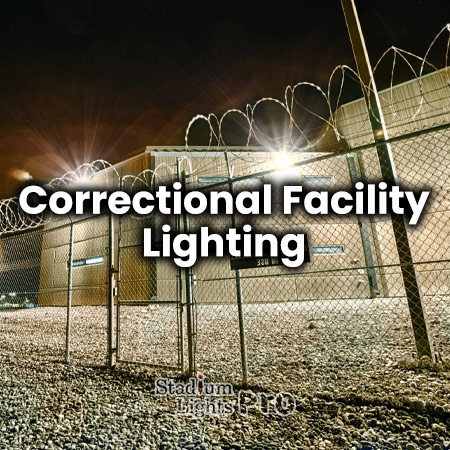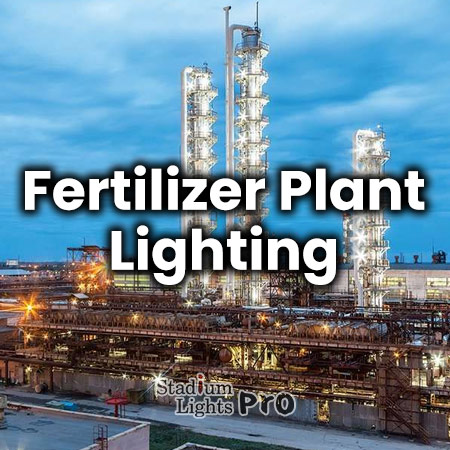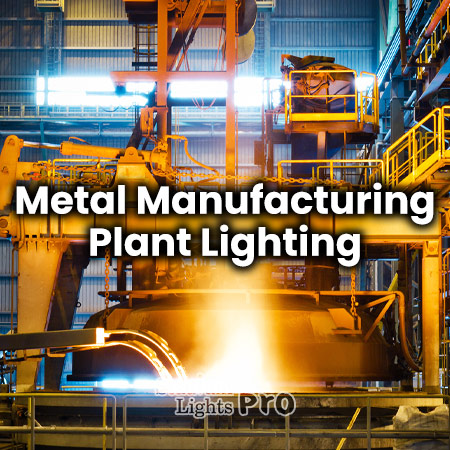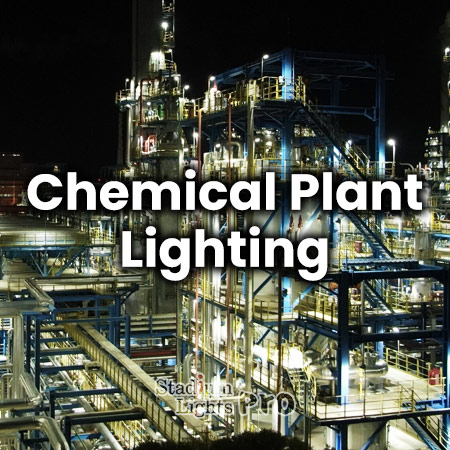Military bases play a critical role in national defense, serving as hubs for training, operations, and safeguarding the nation’s security. Ensuring the safety and functionality of these bases is paramount, and one often overlooked aspect of their infrastructure is lighting. Proper military base lighting is not just about visibility; it is about security, efficiency, and even sustainability.
What lights are used in military base?
Explosion-proof lights
Explosion-proof lights represent an indispensable safety feature in military bases, particularly in areas where the presence of flammable gases or vapors creates a significant risk of explosions. These specialized lighting fixtures are meticulously designed and engineered to operate in environments where even the slightest spark or heat source could trigger a catastrophic event.
One of the key features of explosion-proof lights is their robust construction. They are built with exceptionally sturdy enclosures, typically made of durable materials such as heavy-duty aluminum or stainless steel. These enclosures serve as a protective barrier, encapsulating the light source within, and preventing any potential ignition source from escaping.
Moreover, explosion-proof lights are equipped with sealed connections and joints. These seals are meticulously designed and rigorously tested to ensure airtight integrity. The purpose of these seals is twofold: firstly, to prevent flammable gases or vapors from infiltrating the interior of the lighting fixture, and secondly, to stop any sparks, heat, or electrical arcs generated by the light from venturing outside the enclosure. This dual-layer of protection effectively isolates the lighting system from the surrounding atmosphere, greatly reducing the risk of an explosion even in volatile environments.
Within military bases, explosion-proof lights find prominent placement in critical areas where the handling, storage, or transport of explosive materials is a routine part of operations. Ammunition storage areas, fuel depots, and locations where munitions are loaded onto vehicles or aircraft are prime examples. In these contexts, explosion-proof lighting not only illuminates workspaces but, more importantly, it acts as an insurance policy against potentially disastrous accidents. Should an unforeseen spark or heat source occur within the vicinity of volatile materials, these lights are designed to contain any potential ignition, thus preventing a catastrophic explosion.
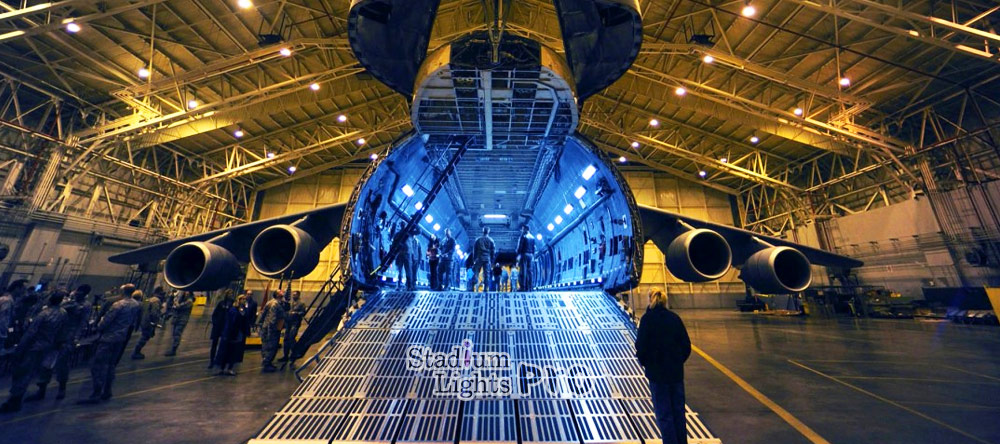
Heat-proof lights
Heat-resistant lighting is a specialized type of illumination designed to thrive in high-temperature environments without compromising its functionality or safety. These lights are engineered to withstand extreme heat conditions that would render standard lighting systems ineffective or pose a significant risk.
One of the primary features of heat-resistant lighting is the use of special heat-resistant materials in its construction. These materials are carefully selected for their ability to endure elevated temperatures without warping, melting, or deteriorating. Heat-resistant enclosures and components are typically made from materials such as high-temperature ceramics, refractory metals, or advanced polymers that exhibit exceptional heat tolerance.
Furthermore, heat-resistant lights often incorporate advanced cooling mechanisms to maintain their performance in hot environments. These mechanisms can include heat sinks and ventilation systems. Heat sinks are designed to absorb and dissipate excess heat generated by the lighting fixture, preventing it from reaching critical components that could be damaged by overheating. Ventilation systems help in maintaining a stable operating temperature by facilitating the flow of air around the lighting unit, further aiding in heat dissipation.
The applications for heat-resistant lighting within military bases are numerous, but they are particularly vital in areas where extreme heat is generated.
Aircraft engines
Military aircraft engines operate at extremely high temperatures. Heat-resistant lighting is crucial in hangars and maintenance areas where maintenance personnel need clear visibility to inspect, repair, or perform maintenance on these engines.
Engine maintenance areas
Apart from aircraft engines, military vehicles, including tanks and armored vehicles, have powerful engines that produce substantial heat. Lighting in engine maintenance areas must withstand these high temperatures to ensure safe and efficient maintenance procedures.
Industrial environments
Some military bases may have industrial facilities where high-temperature processes are carried out. Heat-resistant lighting is essential in these settings to illuminate work areas without risking the integrity of the lighting system.
Vandal-proof lights
Vandal-proof lights are an essential component of lighting systems in environments where there is a risk of intentional damage, tampering, or physical impact. These specialized lighting fixtures are specifically engineered to withstand external forces and malicious actions, ensuring they remain operational and effective even in challenging circumstances.
The key characteristics of vandal-proof lights include.
Durable materials
Vandal-proof lights are constructed using exceptionally tough and resilient materials. Common choices include heavy-duty polycarbonate or tempered glass for the light covers and enclosures. These materials have remarkable resistance to breaking or shattering, making them highly effective in preventing damage caused by impacts or vandalism.
Reinforced enclosures
The enclosures of vandal-proof lights are designed to provide robust protection for the internal components of the fixture. They are often made from rugged materials such as die-cast aluminum or stainless steel, which are capable of withstanding physical blows and attempts to dismantle the fixture.
Tamper-resistant fasteners
Vandal-proof lights typically use specialized tamper-resistant fasteners and hardware, which are challenging to remove without the appropriate tools. This feature discourages unauthorized individuals from attempting to open or disassemble the lighting fixture.
Impact-resistant design
Vandal-proof lights are engineered to absorb and dissipate the force of impacts, reducing the risk of damage to both the light source and the enclosure. Some fixtures incorporate shock-absorbing components or cushioning materials to enhance their impact resistance.
Weatherproofing
Many vandal-proof lights are designed to be weatherproof, capable of withstanding exposure to rain, snow, dust, and other environmental factors. This weatherproofing ensures that the lights remain operational and reliable even in adverse weather conditions.
Secure mounting
The mounting systems for vandal-proof lights are often designed to be secure and resistant to tampering. They may include anti-rotation features or locking mechanisms to prevent unauthorized adjustments or removal.
Versatile applications
Vandal-proof lights are commonly installed in areas where there is a heightened risk of vandalism, such as public spaces on military bases, recreational areas, or locations near perimeter fencing. They may also be used in high-traffic areas or places where accidental impacts are more likely.
Waterproof lights
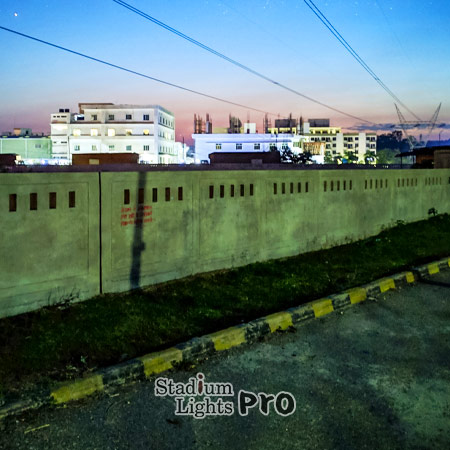 Waterproof lighting serves as an indispensable asset in the outdoor areas of military bases, where exposure to harsh weather conditions is a constant reality. These specialized lighting fixtures are meticulously designed and engineered to withstand the elements, ensuring their continuous functionality even in adverse weather scenarios.
Waterproof lighting serves as an indispensable asset in the outdoor areas of military bases, where exposure to harsh weather conditions is a constant reality. These specialized lighting fixtures are meticulously designed and engineered to withstand the elements, ensuring their continuous functionality even in adverse weather scenarios.
A defining feature of waterproof lighting is its ability to prevent water ingress. These lights are constructed with robust seals and gaskets that create an impermeable barrier, preventing moisture, rain, snow, or other forms of precipitation from penetrating the fixture’s interior. This safeguard is essential in maintaining the integrity of the lighting system and preventing electrical malfunctions or short circuits that could compromise its functionality.
The applications of waterproof lighting within military bases are diverse and multifaceted. These lights are strategically deployed in areas where reliability, visibility, and safety are paramount.
Outdoor pathways
Waterproof lighting illuminates pedestrian walkways, ensuring that military personnel can move safely and comfortably during inclement weather. This is crucial for maintaining operational readiness and safety, particularly in emergency situations.
Vehicle parking areas
Outdoor parking areas often require dependable lighting to facilitate the safe and efficient movement of vehicles. Waterproof lights in these areas provide visibility and security even during heavy rain or snowfall.
Exterior building lighting
Military bases often feature a range of buildings, from barracks to administrative offices. Waterproof lighting fixtures are employed to illuminate the exteriors of these structures, enhancing security and navigability, especially during nighttime or adverse weather conditions.
Security posts and checkpoints
In outdoor security installations, such as checkpoints and guard posts, waterproof lighting is essential to ensure that security personnel can carry out their duties effectively, regardless of the weather conditions.
Perimeter fencing
Many military bases are secured by perimeter fencing, and waterproof lighting plays a crucial role in maintaining the visibility and security of these areas, deterring unauthorized access.
Corrosion-resistant lights
Corrosion-resistant lights serve as a vital component in the lighting systems of military bases, particularly those located in coastal or marine environments where the corrosive effects of saltwater and other environmental factors pose a constant threat. These specialized lighting fixtures are engineered to endure the relentless challenges posed by the corrosive forces of saltwater, humidity, and other corrosive agents, ensuring their long-term functionality and reliability.
One of the defining characteristics of corrosion-resistant lights is the use of materials and coatings specifically chosen for their exceptional resistance to corrosion. These lighting fixtures are typically crafted from robust materials like marine-grade stainless steel, which is highly resistant to rust and deterioration. Besides, they often feature specialized coatings that provide an extra layer of protection against the corrosive effects of saltwater, airborne salt particles, and other environmental factors that can erode or degrade standard lighting materials.
The applications of corrosion-resistant lighting within military bases are particularly crucial in areas where exposure to saltwater or corrosive conditions is prevalent.
Naval bases
Naval bases, where ships and submarines are docked and serviced, are subjected to constant exposure to saltwater. Corrosion-resistant lighting is essential in these settings to ensure the safety and efficiency of maritime operations and maintenance procedures.
Coastal defense installations
Military installations located along coastlines or in proximity to marine environments often rely on corrosion-resistant lighting for their security and operational lighting needs. These fixtures provide dependable illumination while withstanding the corrosive effects of salt-laden air and water.
Harbor and pier lighting
Lighting on docks, piers, and harbor facilities must endure the challenges of saltwater exposure. Corrosion-resistant lights in these areas help guide ships and personnel safely during loading, unloading, and docking operations.
Night vision-compatible lights
Night vision-compatible lights play a pivotal role in military operations conducted under cover of darkness. These specialized lighting fixtures emit specific wavelengths of light that are carefully calibrated not to interfere with night vision technology, ensuring that military personnel can maintain operational effectiveness during nighttime missions, often in situations where visibility is severely limited.
One of the key features of night vision-compatible lights is their emission of light in a spectrum that is nearly invisible to standard night vision devices. This minimizes the risk of overexposing the image seen through night vision goggles or scopes, which could temporarily blind or disorient the user. By emitting light at wavelengths outside the range that night vision technology detects, these lights enable military personnel to work effectively in low-light or no-light conditions while preserving the full functionality of their night vision equipment.
The applications of night vision-compatible lights are diverse and strategically significant.
Command centers
Night vision-compatible lighting is indispensable in command centers and tactical operations rooms where military personnel need to access documents, maps, and screens without compromising the effectiveness of their night vision devices. These lights provide essential illumination for tasks that require visible light, such as reviewing maps or conducting briefings.
Vehicles
Military vehicles equipped with night vision systems, including tanks, armored vehicles, and helicopters, rely on night vision-compatible lighting for tasks like reading instrumentation, navigating maps, and communicating with crew members. These lights enable safe and efficient nighttime operations while preserving situational awareness.
Aircraft
In aircraft, whether fixed-wing or rotary-wing, night vision-compatible lighting is essential for cockpit instrumentation, navigation, and communication. These lights are carefully designed to ensure that the pilot’s vision through night vision goggles is not compromised while providing sufficient visibility for cockpit tasks.
Personnel equipment
Soldiers and special forces often carry compact, handheld night vision-compatible lights to illuminate their immediate surroundings without revealing their positions to potential threats. These lights are essential for tasks like reading maps, conducting searches, or signaling team members.
Emergency lighting
Emergency lighting systems serve as a critical component of safety infrastructure within military bases, ensuring the provision of illumination during power outages, fires, natural disasters, or other emergency situations. These specialized lighting systems are meticulously designed and strategically placed to provide reliable illumination when it is needed most, often in scenarios where regular lighting sources have failed.
Key characteristics and components of emergency lighting systems include,
Backup power sources
The hallmark of emergency lighting systems is their ability to continue operating when the primary power source is disrupted. To achieve this, these systems are equipped with backup power sources, such as rechargeable batteries, generators, or uninterruptible power supplies (UPS). These backup sources can provide electricity for the emergency lighting fixtures even in the absence of mains power.
Automatic activation
Emergency lighting systems are designed to activate automatically in response to a power outage or other predetermined emergency conditions. This ensures that critical areas are swiftly illuminated when the primary lighting fails, reducing the risk of accidents or confusion during an emergency.
Strategic placement
Emergency lighting fixtures are strategically positioned in key locations throughout military bases, with a focus on areas where safe and rapid evacuation or emergency response is critical. Common placement areas include evacuation routes, stairwells, hallways, control rooms, medical facilities, fire exits, and assembly points.
Maintaining visibility
The purpose of emergency lighting is to maintain visibility to facilitate safe evacuation, firefighting, medical response, or other critical actions. The fixtures are designed to provide adequate illumination levels, typically above a minimum threshold, to ensure that individuals can move safely and effectively during an emergency.
Compliance with standards
Military bases adhere to strict safety standards and regulations regarding emergency lighting, which may vary by region. Emergency lighting systems are designed and installed in accordance with these standards to ensure their reliability and effectiveness.
Smart lighting
Smart lighting systems represent a cutting-edge solution for lighting management within military bases, offering advanced capabilities that go beyond traditional lighting systems. These systems leverage technology to provide remote control, dimming, scheduling, and automation features, resulting in enhanced energy efficiency, adaptability, and overall lighting performance.
Remote control
Smart lighting systems can be remotely controlled, allowing military personnel to adjust lighting levels, turn lights on or off, or even change the color temperature from a central control point. This remote control capability is particularly valuable for optimizing lighting in large or complex installations.
Dimming
Smart lights can be dimmed to varying levels of brightness, providing flexibility in adjusting illumination to meet specific needs. This feature not only saves energy but also allows for creating different lighting scenarios depending on the time of day or the task at hand.
Scheduling
Smart lighting systems enable users to create lighting schedules that align with operational requirements. Lights can automatically turn on or off at predetermined times, ensuring efficient use of energy and compliance with security protocols.
Adaptive lighting
These systems can incorporate sensors such as occupancy detectors, daylight sensors, and motion sensors. By monitoring environmental conditions and human presence, smart lighting can adjust lighting levels in real-time, ensuring that areas are only illuminated when needed.
Energy efficiency
Smart lighting is designed to be energy-efficient. By automatically adjusting lighting levels and turning lights off in unoccupied areas, these systems reduce energy consumption, resulting in cost savings and reduced environmental impact.
Integration with security
Smart lighting can be seamlessly integrated with security systems. When triggered by security sensors, lights can automatically illuminate specific areas, deterring intruders and aiding security personnel in responding to potential threats.
Customization
Users can customize lighting settings based on specific needs, whether it’s creating different lighting scenes for training exercises, adjusting lighting color for tactical purposes, or setting different illumination levels for various areas of the base.
Maintenance alerts
Smart lighting systems can provide maintenance alerts by monitoring the condition and performance of individual fixtures. This proactive approach to maintenance ensures that lighting remains reliable and reduces the likelihood of unexpected failures.
The applications of smart lighting systems in military bases are wide-ranging.
- Offices and facilities – Smart lighting can be used in administrative buildings, offices, and facilities to create comfortable and energy-efficient workspaces.
- Training areas – Lighting in training facilities can be tailored to match specific training scenarios, enhancing the effectiveness of training exercises.
- Security – Smart lighting can be integrated with security systems to improve perimeter security and assist surveillance efforts.
- Runways and airfields – Smart lighting systems can be employed on runways and airfields to optimize runway lighting levels and improve safety during aircraft operations.
Camouflage lighting
Camouflage lighting systems represent a specialized lighting solution with a unique and strategic purpose within military operations. These systems are designed to reduce the visibility of a military base or installation from a distance by effectively blending the lighting with the natural surroundings. Camouflage lighting is particularly crucial in scenarios where concealment and reduced visibility are critical, often in tactical or covert military operations where staying hidden is of paramount importance.
- Natural environment integration – Camouflage lighting fixtures are engineered to emit light that closely matches the color spectrum and intensity of the surrounding natural environment. By mimicking the ambient light conditions, these systems avoid creating noticeable contrasts that would otherwise attract attention.
- Reduced glare – Camouflage lighting fixtures are designed to emit soft, diffuse light patterns that minimize glare and harsh reflections. This ensures that the lighting is subtle and does not cast shadows or illuminate areas that should remain concealed.
- Variable intensity – Many camouflage lighting systems feature adjustable brightness levels to adapt to changing lighting conditions or operational requirements. This flexibility allows military personnel to maintain an optimal balance between visibility and concealment.
- Infrared (IR) capability – Some camouflage lighting systems incorporate infrared lighting technology, which emits light that is invisible to the naked eye but can be detected by night vision equipment. This feature is valuable for maintaining stealth while still providing illumination for night vision-equipped military personnel.
Camouflage lighting is employed in various military scenarios.
Forward Operating Bases (FOBs)
In forward areas where troops are deployed in potentially hostile environments, camouflage lighting helps maintain a low profile, reducing the likelihood of detection by adversaries.
Observation posts
Military observation posts and sniper positions may use camouflage lighting to ensure that personnel can operate effectively without revealing their presence.
Tactical operations
During tactical operations, such as reconnaissance missions or special forces operations, camouflage lighting assists in maintaining stealth and surprise, enabling troops to move covertly and avoid detection.
Covert communication
Camouflage lighting can be used in communication facilities to illuminate equipment and maintain operational security while avoiding unnecessary visibility.
Border and perimeter security
In border and perimeter security applications, camouflage lighting helps secure sensitive areas without drawing attention to the presence of security installations.
What are the military base lighting standards?
Military base lighting standards can vary depending on the country, the specific military branch, and the intended use of the area. These standards are typically developed to ensure that lighting within military bases meets specific requirements for safety, security, and operational effectiveness.
Illuminance levels (Lux)
How much lux is needed for a military base? Illuminance levels, typically measured in lux (lx), play a critical role in military base lighting standards. These levels specify the amount of light needed in various outdoor and indoor areas to ensure safety, security, and operational efficiency.
General outdoor areas (10-20 lux minimum)
Pedestrian walkways
In pedestrian walkways, such as footpaths and sidewalks, a minimum illuminance of 10-20 lux is typically recommended. This level of lighting ensures that personnel can move safely and comfortably, reducing the risk of accidents or obstacles in their path.
Parking lots
General outdoor parking areas also require 10-20 lux of illuminance. Adequate lighting in parking lots enhances security by deterring unauthorized access and promoting visibility, which can be essential for surveillance and preventing incidents.
General outdoor spaces
Open outdoor spaces within military bases, including courtyards, common areas, and gathering places, benefit from 10-20 lux of lighting. This level of illuminance provides a sense of security and comfort for personnel using these areas after dark.
Security and perimeter lighting (20-50 lux minimum)
Security and perimeter areas
To enhance security and deter unauthorized access, security and perimeter lighting typically requires higher illuminance levels, ranging from 20 to 50 lux or more. Adequate lighting in these areas is crucial for surveillance cameras to capture clear images and for security personnel to monitor and respond to potential threats effectively.
Vehicle movement areas (50-100 lux minimum)
Vehicle parking
Vehicle parking areas, including parking lots and garages, necessitate a higher illuminance level of 50-100 lux. This level of lighting ensures safe vehicle maneuvering, facilitates parking, and enhances security by discouraging theft and vandalism.
Loading zones and access roads
Areas where vehicles are loaded and unloaded, as well as access roads within the military base, also require 50-100 lux of illuminance. Adequate lighting in these areas is essential to prevent accidents, ensure efficient logistics operations, and maintain overall safety.
Specific task areas (Varies)
Task-specific areas within military bases may have unique requirements tailored to the nature of the tasks performed. For instance, maintenance or inspection areas, where detailed work is carried out, may need higher illuminance levels to ensure that tasks can be performed safely and efficiently. The specific lux levels for task areas will depend on the nature of the work and local safety regulations.
Uniformity
Achieving uniformity in lighting distribution is essential to minimize shadows. Shadows can hinder visibility, making it difficult to detect potential threats or obstacles. Proper uniformity ensures that the entire area is adequately illuminated, reducing shadowed areas and creating a safer environment.
Uniform lighting provides consistent visibility, enabling military personnel to perform tasks and movements with confidence. It ensures that there are no abrupt transitions between bright and dark areas, which could cause discomfort and potential hazards.
Color temperature (Kelvin)
Color temperature influences how objects and surroundings appear under different lighting conditions. For general outdoor and security lighting in military bases, a color temperature of 4000K to 5000K, often referred to as “cool white,” is commonly chosen. This color temperature provides a balance between good visibility and accurate color rendition, allowing personnel to distinguish objects and individuals accurately.
Color Rendering Index (CRI)
The Color Rendering Index (CRI) measures how accurately a light source renders colors compared to natural daylight. A CRI of 70 or higher is typically recommended for outdoor and security lighting. This ensures that colors are represented accurately, which is crucial for tasks like facial recognition and identifying objects or individuals in security footage.
Glare control
Glare occurs when there is excessive brightness or contrast between light and dark areas. It can cause discomfort and reduce visibility. In military base lighting, glare control measures such as shielding fixtures, using cutoff fixtures, and properly placing lights help prevent glare and ensure a more comfortable and safer environment.
Emergency lighting
Emergency lighting in military bases is designed to provide illumination during power outages or emergencies. These standards are essential to ensure that critical areas, escape routes, and important equipment remain lit when regular power sources fail. Compliance with relevant regulations is crucial to guarantee the safety and orderly evacuation of personnel.
Energy efficiency
Energy efficiency is a key consideration in military bases, as it helps reduce operating costs and environmental impact. LED lighting technology is widely adopted for its energy-saving capabilities, long lifespan, and reduced maintenance requirements. LED lighting contributes to sustainability efforts and cost-effective lighting solutions.
Lighting controls
Lighting controls, such as motion sensors and timers, are deployed to reduce energy consumption in areas with intermittent use. These controls automatically turn off or dim lights when they are not needed, contributing to energy savings while maintaining security and convenience.
Lighting directionality
Properly directed lighting is essential to minimize light pollution, which can have adverse effects on the surrounding environment and visibility. By directing light precisely where it is needed and avoiding unnecessary spillage, military bases can reduce their environmental impact and maintain operational security.
Cost of military base and facility lighting
The cost of lighting a military base can vary significantly depending on a multitude of factors. However, to provide a ballpark estimate, let’s break down the potential costs in terms of annual expenses.
General outdoor lighting ($100,000 to $500,000+ per year)
General outdoor lighting encompasses the illumination of pedestrian walkways, parking lots, and common outdoor areas. The costs in this category vary widely depending on the size and extent of the base. Smaller bases may have annual expenses toward the lower end of this range, while larger bases with extensive outdoor spaces could incur higher costs.
Security and perimeter lighting ($200,000 to $1 million+ per year)
Security and perimeter lighting is crucial for safety and deterring unauthorized access. The cost of these systems can fluctuate significantly based on the level of security required. Bases with more stringent security needs may invest in advanced lighting technologies, surveillance integration, and additional maintenance.
Vehicle movement areas ($200,000 to $1 million+ per year)
Vehicle movement areas, including parking zones, loading areas, and access roads, require effective lighting to ensure safe and efficient operations. Costs in this category depend on the size and complexity of the vehicle movement zones within the base.
Specific task areas ($100,000 to $500,000+ per year)
Task-specific areas with higher illuminance requirements, such as maintenance or inspection zones, often demand specialized lighting solutions. The costs can vary based on the specific needs and complexity of the tasks carried out in these areas.
Uniformity and glare control (10-20% of total costs)
Implementing measures to ensure uniformity and glare control in lighting design can add approximately 10-20% to the total lighting costs. Proper uniformity and glare control contribute to the safety and comfort of personnel.
Emergency lighting ($50,000 to $200,000+ per year)
Adequate emergency lighting is essential to meet safety regulations and ensure proper illumination during power outages or emergencies. Costs can vary based on the size and complexity of the base, as well as the extent of the emergency lighting system.
Energy efficiency and controls ($100,000 to $500,000+ per year)
Investments in energy-efficient technologies like LED lighting and lighting controls can result in initial expenses but often lead to long-term cost savings. The annual costs for energy-efficient lighting depend on the extent of adoption and the energy consumption patterns within the base.
Renewable energy (Initial investment of several million to tens of millions)
Military bases committed to sustainability may opt for renewable energy sources like solar panels or wind turbines. These projects can have substantial upfront costs, ranging from several million dollars to tens of millions, but may yield significant long-term savings and environmental benefits.
Can we use solar lights in military base?
Yes, solar lights can be a viable and practical option for lighting in military bases and facilities, depending on the specific needs and circumstances. Solar lighting offers several advantages that make it a valuable choice for various applications within military installations.
Energy independence
Solar lights operate independently of the electrical grid, generating electricity directly from sunlight. This energy autonomy is particularly valuable in remote or inaccessible areas of military bases where connecting to the grid may be logistically challenging or cost-prohibitive. This means that even in isolated locations, lighting can be reliably powered without relying on external infrastructure.
Reduced operating costs
One of the most significant advantages of solar lighting is its minimal ongoing operating costs. Unlike grid-powered lighting systems that incur electricity bills, solar lights harness free solar energy once installed. While there is an initial investment in solar lighting systems, the absence of grid electricity costs leads to significant long-term savings. These reduced operating expenses can be especially beneficial for military bases aiming to optimize their budgets.
Environmental benefits
Solar lighting is environmentally friendly and aligns with sustainability goals. By generating clean energy from sunlight, solar lights reduce the reliance on fossil fuels and curb carbon emissions. This not only lowers the ecological impact of military bases but also contributes to broader environmental conservation efforts. It can also enhance the base’s reputation for environmental responsibility.
Flexibility and mobility
Solar lights are highly portable and easy to relocate, making them versatile for various military applications. They are well-suited for temporary installations in field operations, training exercises, or remote camps. The mobility of solar lighting allows military personnel to adapt to changing operational needs and deploy lighting where and when it’s needed most.
Security and safety
Solar lights play a crucial role in enhancing security and safety within military bases. They provide reliable illumination in critical areas, including access points, perimeter fencing, and remote outposts. This lighting ensures that security personnel can effectively monitor and respond to potential threats. Besides, during power outages or emergencies, solar lights continue to operate, maintaining visibility and safety throughout the base.
Low maintenance
Solar lighting systems are generally low maintenance due to their simple design and fewer moving parts compared to traditional lighting systems. Routine inspections and occasional cleaning are typically all that is required to keep solar lights in optimal working condition. The reduced maintenance demands contribute to cost savings and operational efficiency.
Quick deployment
Solar lights can be rapidly deployed in emergency situations or for temporary lighting needs. Unlike grid-powered lighting, which requires complex electrical infrastructure, solar lights can be installed quickly without the need for extensive wiring or electrical connections. This rapid deployment capability enhances the base’s readiness and adaptability in response to changing circumstances.
While solar lighting offers numerous advantages, it’s necessary to consider specific factors when implementing it in military bases.
Limitations
Sunlight availability
The effectiveness of solar lighting is directly influenced by the availability of sunlight in the region where the military base is located. In regions with limited sunlight due to factors like geographic location or frequent cloudy weather, there are a few key considerations.
- Supplemental lighting – To ensure uninterrupted operation during periods of reduced sunlight, supplemental lighting sources may be necessary. This could include traditional grid-powered lighting or backup power systems, such as batteries or generators, which can provide power when sunlight is scarce.
- Energy storage – Incorporating energy storage solutions, such as high-capacity batteries, allows excess energy generated during sunny days to be stored and used during nighttime or cloudy conditions. This ensures continuous lighting operation and contributes to energy resilience.
Lighting requirements
Different areas within a military base may have unique lighting requirements based on their functions and security needs. It’s essential to match the solar lighting system to these specific requirements. For example,
- Security lighting – Areas requiring robust security, such as access points or perimeter fencing, may need brighter and more powerful solar lights to maintain visibility and deter potential threats.
- Pathway lighting – Pathways and walkways may require lower-intensity, decorative lighting to guide personnel safely while minimizing light pollution.
- Runway lighting – Runway lighting for military airfields necessitates precise photometric specifications to meet aviation safety standards. Specialized solar lighting systems designed for this purpose must adhere to these standards.
Budget and initial investment
While solar lighting offers long-term cost savings, the initial investment can be higher than traditional grid-powered lighting systems. Factors influencing costs include the size of the installation, the quality of solar panels and fixtures, and any required supplemental equipment (e.g., energy storage). Despite the upfront costs, we may consider the potential for significant energy savings, reduced maintenance expenses, and environmental benefits over the life of the system. A thorough cost-benefit analysis can help determine the return on investment and justify the initial expenditure.
Location and security
The strategic placement of solar lights should take into account security concerns and the need to prevent tampering or theft.
- Security measures – Implementing physical security measures to protect solar lighting systems, such as tamper-resistant fixtures, anti-vandalism designs, and secure mounting hardware.
- Maximizing sun exposure – The placement of solar panels and lights should maximize exposure to sunlight. Proper orientation and positioning are critical to optimize energy generation. In locations with obstructions or shading, adjustments may be needed to ensure efficient solar harvesting.
Significance of military base lighting
Enhancing security
Military bases are high-security environments where access must be tightly controlled. Effective lighting is a vital tool in deterring unauthorized access and intrusions. Well-lit perimeters and access points make it harder for potential threats to approach undetected, providing security personnel with better visibility and response capabilities. What is more, motion-activated lighting can quickly draw attention to suspicious activity, improving the overall security posture of the base.
Supporting operations
Military bases operate around the clock, and effective lighting is essential for maintaining 24/7 readiness. Proper illumination of runways, taxiways, and airfields ensures safe flight operations, allowing aircraft to take off and land even in low-light conditions. Similarly, well-lit training facilities and vehicle maintenance areas enable military personnel to perform their duties efficiently, minimizing downtime.
Enhancing safety
Safety is a top priority on military bases, and adequate lighting plays a significant role in achieving this goal. Properly illuminated walkways, staircases, and other high-traffic areas reduce the risk of accidents and injuries. In emergency situations, such as fires or medical emergencies, good lighting can help responders navigate and provide assistance more effectively.
Energy efficiency
While military bases require robust lighting systems, they also recognize the importance of energy conservation and sustainability. LED lighting technology has become increasingly prevalent in military installations due to its energy efficiency and longevity. LEDs consume less energy, last longer, and require less maintenance than traditional lighting options, reducing operational costs and environmental impact.
Night vision considerations
Many military operations and training exercises occur under cover of darkness. In such situations, it is crucial to have lighting systems that are compatible with night vision technology. Specially designed lighting that emits wavelengths outside the range of night vision devices or includes filters to make them compatible can be invaluable for maintaining operational effectiveness in low-light conditions.
Adaptability and control
Modern military base lighting systems are designed to be adaptable and controllable. This allows for different lighting scenarios based on security levels and operational requirements. For instance, lighting levels can be adjusted during heightened security alerts or dimmed in areas with minimal activity to conserve energy.
Environmental considerations
Sustainability and environmental responsibility are growing concerns for military bases. The selection of lighting fixtures, including the use of energy-efficient LEDs and smart lighting controls, can help minimize the environmental impact of military operations. Besides, reducing light pollution can benefit nearby communities and ecosystems.
Conclusion
Proper military base lighting is an integral component of national defense. It enhances security, supports operations, and ensures the safety of personnel. As technology advances, military bases continue to invest in energy-efficient and sustainable lighting solutions, further underscoring the importance of effective illumination in maintaining readiness and security. Whether it’s illuminating runways for aircraft, securing perimeters, or supporting nighttime training exercises, military base lighting is a crucial element in safeguarding our nation’s interests and personnel.

